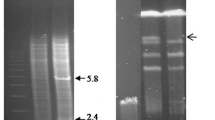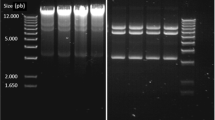Summary
The genes responsible for the expression of type 1 fimbriae, produced by the majority of E. coli strains, have been cloned from an E. coli K12 strain. The “passenger” DNA from an initial cosmid clone was reduced in size and subcloned in pACYC184 and pBR322 vectors. A DNA fragment of around 8 kbp was found to be required for the biosynthesis of type 1 fimbriae. This was further studied by transposon-mediated insertional inactivation and by BAL31-mediated deletions. Four genes, designated fimA, B, C, and D were found to be involved in the synthesis of the fimbriae. They encoded proteins that in their processed form appeared with apparent molecular weights of 16.5 kd, 23 kd, 26 kd, and 89 kd, the 16.6 kd polypeptide being the fimbrial subunit. The order to the genes was found to be: fimB, fimA, fimC, and fimD, organized in three transcriptional units.
Similar content being viewed by others
References
Adler HI, Fisher WD, Cohon H, Hardigree AA (1967). Miniature Escherichia coli cells deficient in DNA. Proc Natl Acad Sci USA 57:321–326
Andreoli PM, Overbeeke N, Veltkamp E, van Embden JDA, Nijkamp HJJ (1978) Genetic map of the bacteriocinogenic plasmid C10 DF13 derived by insertion of the transposon Tn901. Mol Gen Genet 160:1–11
Bolivar F, Rodriguez RL, Greene PJ, Betlak MC, Heyneker HL, Boyer HW (1977) Construction and characterization of new cloning vehicles II. A multipurpose cloning system. Gene 2:95–113
Boyer HW, Roulland-Dussoix D (1976) A complementation analysis of the restriction and modification of DNA in Escherichia coli. J Mol Biol 41:459–472
Brinton CC Jr, Gemski P, Falkow S, Baron LS (1961) Location of the piliation factor on the chromosome of Escherichia coli. Biochem Biophys Res Commun 5:293–298
Chang ACY, Cohen SN (1978) Construction and characterization of amplifiable multicopy DNA cloning vehicles derived from the P15A cryptic miniplasmid. J Bacteriol 134:1141–1156
Davis RW, Botstein D and Roth (1980) Advanced bacterial genetics. A manual for genetic engineering. Cold Spring Harbor Laboratory, New York
Die I van, Hondel V van den, Hamstra H-J, Hoekstra W, Bergmans H (1983) Studies on the fimbriae of an Escherichia coli 06:K2:H1:F7 strain: molecular cloning of a DNA fragment encoding a fimbrial antigen responsible for mannose-resistant haemagglutination of human erythrocytes. FEMS Microbiol Lett 19:77–82
Die I van, Megen I van, Hoekstra W, Bergmans H (1984) Molecular organization of the genes involved in the production of a uropathogenic Escherichia coli 06:K2:H1:F7 strain. Mol Gen Genet 194:528–533
Duguid JP, Smith IW, Dempster G, Edmunds PN (1955) Nonflagellar filamentous appendages and hemagglutinating activity in Bacterium coli. J Pathol Bacteriol 70:335–348
Duguid JP, Clegg S, Wilson M (1979) The fimbrial and nonfimbrial hemagglutinins of Escherichia coli. J Med Microbiol 12:213–227
Eisenstein BI (1981) Phase variation of type I fimbriae in Escherichia coli is under transcriptional control. Science 214:337–339
Eshdat Y, Silverblatt FJ, Sharon N (1981) Dissociation and reassembly of Escherichia coli type 1 pili. J Bacteriol 148:308–314
Freitag CS, Eisenstein BI (1983) Genetic mapping and transcriptional orientation of the fimD gene. J Bacteriol 156:1052–1058
Graaf FK de, Krenn BE, Klaasen P (1984) Organization and expression of genes involved in the biosynthesis of K99 fimbriae. Infect Immun 43:508–514
Hagberg L, Jodal U, Korhonen TK, Lindin-Johnson G, Linberg U, Svanborg-Eden C (1981) Adhesion, haemagglutination and virulence of Escherichia coli causing urinary tract infection. Infect Immun 31:564–570
Holmes DS, Quigley M (1981) A rapid boiling method for the preparation of bacterial plasmids. Anal Biochem 114:193–197
Iyer R, Darby V, Holland IB (1976) Changes in membrane proteins of Escherichia coli K12 mediated by bacteriophage Ike-specified plasmids. Biochem Biophys Acta 453:311–318
Klemm P (1984) The fimA gene encoding the type 1 fimbrial subunit of Escherichia coli: nucleotide sequence and primary structure of the protein. Eur J Biochem 143:395–399
Klemm P, Ørskov I, Ørskov F (1982) F7 and type 1-like fimbriae from three Escherichia coli strains isolated from urinary tract infection-protein chemical and immunological aspects. Infect Immun 36:462–468
Meyenburg K von, Hansen FG, Nielsen LD, Jørgensen P (1977) Origin of replication, oriC, of the Escherichia coli chromosome: Mapping of genes relative to R. EcoRI cleavage sites in the oriC region. Mol Gen Genet 158:101–109
Meyenburg K von, Hansen FG, Nielsen LD, Riise E (1978) Origin of replication, oriC, of the Escherichia coli chromosome on specialized transducing phages λasn. Mol Gen Genet 160:287–295
Mooi FR, Harms N, Bakker D, Graaf FK de (1981) Organization and expression of genes involved in the production of the K88ab antigen. Infect Immun 32:1155–1163
Mooi FR, Wouters C, Wijfjes A, de Graaf FK (1982) Construction and characterization of mutants impaired in the biosynthesis of the K88 antigen. J Bacteriol 150:512–521
Normark S, Lark D, Hull R, Norgren M, Båga M, O'Hanley P, Schoolnik G, Falkow S (1983) Genetics of digalactoside-binding adhesin from a uropathogenic Escherichia coli strain. Infect Immun 41:942–949
Old DC (1972) Inhibition of interaction between fimbrial haemagglutinins and erythrocytes by D-mannose and other carbohydrates. J Gen Microbiol 71:149–157
Orndorff PE, Falkow S (1984) Organization and expression of genes responcible for type 1 pilliation in Escherichia coli. J Bacteriol 159:736–744
Ørskov I, Ørskov F, Birch-Andersen A (1980) Comparison of Escherichia coli fimbrial antigen F7 with type 1 fimbriae. Infect Immun 27:657–666
Ørskov I, Ørskov F, Birch-Andersen A, Klemm P, Svanborg-Eden C (1982) Protein attachment factors: Fimbriae in adhering Escherichia coli strains, Seminars in infectious disease, vol IV, bacterial vaccines. Thieme-Stratton Inc., New York, pp 97–103
Swaney LM, Liu Y-P, To CM, To CC, Ippen-Ihler K, Brinton Jr CC (1977a) Isolation and characterization of Escherichia coli phase variants and mutants deficient in type 1 pilus production. J Bacteriol 130:495–505
Swaney LM, Liu Y-P, Ippen-Ihler K, Brinton Jr CC (1977b) Genetic complementation analysis of Escherichia coli type 1 somatic pilus mutants. J Bacteriol 130:506–511
Timmis K, Cabello F, Cohen SN (1978) Cloning and characterization of EcoRI and Hind III restriction endonuclease-generated fragments of antibiotic resistance plasmids. Mol Gen Genet 162:121–137
Author information
Authors and Affiliations
Additional information
Communicated by J. Schell
Rights and permissions
About this article
Cite this article
Klemm, P., Jørgensen, B.J., van Die, I. et al. The fim genes responsible for synthesis of type 1 fimbriae in Escherichia coli, cloning and genetic organization. Mol Gen Genet 199, 410–414 (1985). https://doi.org/10.1007/BF00330751
Received:
Issue Date:
DOI: https://doi.org/10.1007/BF00330751




